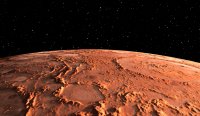How Can We Survive on Mars?
A fifth-grade project-based learning unit harnesses excitement about Mars to develop science, math, engineering, and literacy skills.
Your content has been saved!
Go to My Saved Content.Media stories about colonizing Mars are everywhere. Elon Musk, NASA, the Mars One project—seems like everyone wants to visit the most habitable planet beyond Earth.
Elementary and middle school students love learning about Mars too, so can we use their interest to get them thinking critically about the complex science, math, and engineering needed to survive on another planet? The answer is yes: My fifth-grade students address these issues with research, technology, teamwork, and creativity as part of a roughly two-week Martian Colony project-based learning unit.
Mission to Mars
Our driving question is: How can humans survive on Mars? The answers begin on Earth, as students think about what makes our planet habitable, and by comparison what unique challenges Martian colonists will face. There are many challenges to consider: no oxygen, food, or readily available water; extreme cold and solar radiation; meteorites—sometimes I’m glad I’m too old for such an expedition.
Students working in groups of four or five research all things Mars using books, websites, and videos, some of which I post on my teacher portal and some of which they find. We focus on the human perspective—they don’t need to know the diameter of the planet, but they do need to know the surface temperature and how that will affect their survival.
We also try to incorporate some fun into the unit. Before every mission, NASA crew members design a mission patch for the astronauts’ flight suits. My students do something similar: Some design paper mission patches, complete with spacecraft and images of Earth and Mars. Others create computer-based drawings or even 3D models representing their group, which they often give silly names like the Goat Grandmas or the Flying Banana Peels. One year we used the website Patches4Less to make real cloth patches that cost each student about $2.50.
Applying What They Learn
On a more serious note, students must think about supplies they would need for their voyage. The students consider how much storage space their launch vehicles would hold and what items are mission critical. Is it realistic to bring a herd of cattle to feed Martian colonists? Probably not.
It’s important to give them some parameters for this. I ask students to imagine an empty school bus (with no seats) and to think of items that could fit inside. And I require them to list supplies by category (food, clothing, medical) to help them organize their thinking.
Teams pick a landing location on Mars using Google Earth Pro’s Mars option (look for the image of Saturn on the toolbar). There are no right answers, but they must justify their choices. If they plan to mine Martian ice for water, a location near the polar ice caps might work. Protection from meteors and solar radiation might suggest building in a crater or in one of the Martian canyons.
Our final product is a digital 3D model of the colony, an involved step that takes three or four days to complete. Students must first submit a working blueprint of their colony on grid paper. I set a square footage limit for the colonies, which forces students to make choices about essential elements and encourages them to apply math skills like multiplication, area, and perimeter.
As the Supreme Chancellor of Martian Colonization, I use the blueprint to verify the placement of buildings in the final model. If the blueprint shows a 12 foot by 10 foot science lab in the southwest corner of the colony, I ask students to show me this same building on their model. This encourages them to match their blueprint to their final product and spurs further collaboration between team members. More advanced groups calculate total colony volume by finding the lengths, widths, and heights of their various structures.
In previous years, early versions of the final product used recycled materials like cardboard and aluminum cans and then computer models built with Google Sketchup.
For the past three years, we have designed colonies on Minecraft.edu, an education version of the popular video game that omits the creepers and online communication with other gamers. Our school tech coach helped get things up and running and created a Minecraft server to save all of our work. Many students already know Minecraft, so the learning curve is not steep. I’ve been continually amazed by the solar panels, greenhouses, science labs, and Martian exercise equipment designed using only Minecraft blocks and group ingenuity.
Writing about their colonies accesses another set of skills. Can you persuade me that your colony is the safest and best designed of all the choices out there? Can you produce a travel log detailing daily life on Mars? Or a travel brochure advertising the colony to potential colonists? Students choose the writing form they think best represents their colony.
Presenting What They Learn
I save a day at the end for presentations. In addition to classmates, audiences have included students from other grade levels and sometimes parents. One day I’d like to invite an astronaut or NASA engineer to our presentations as well. The following questions guide feedback from the audience:
- Would you feel safe in this colony?
- What elements of the colony did you think the most creative?
- What suggestions can you give to make this colony better?
Mars is an amazing place, and I hope to inspire students to dream big about the possibilities for human colonization of the Red Planet in their lifetimes.
